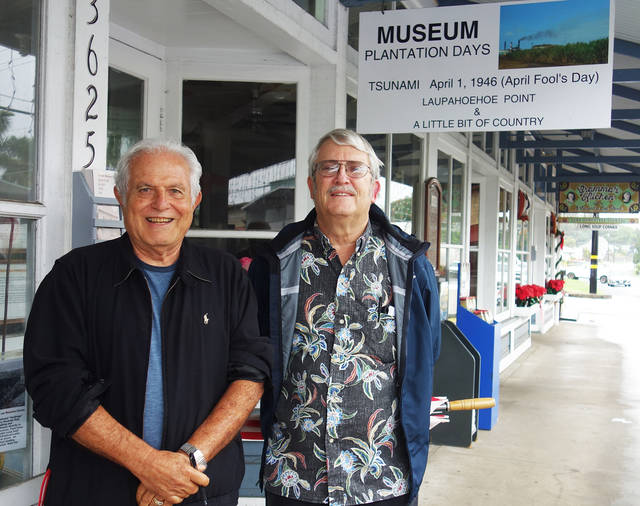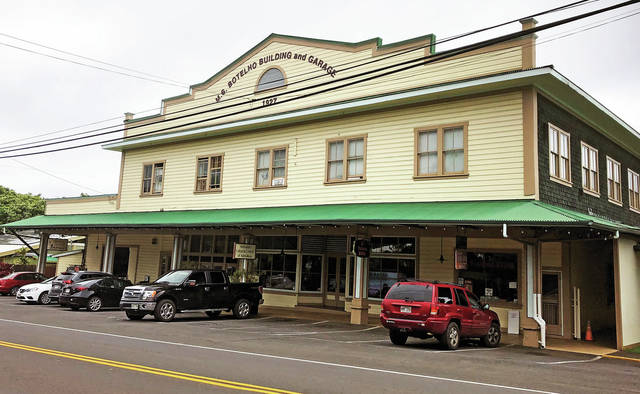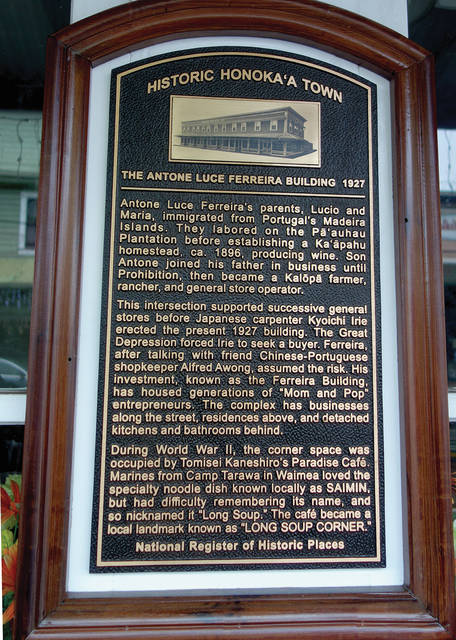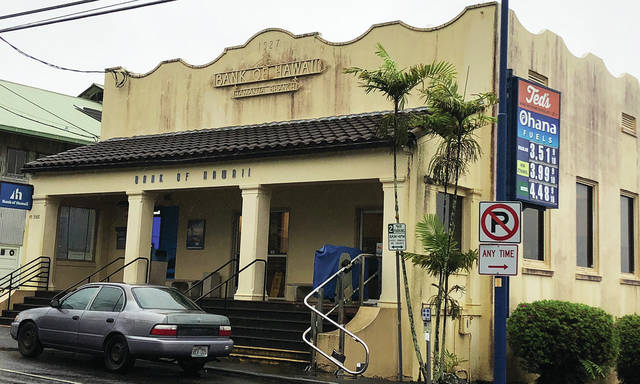A walk down memory lane: Three Honokaa buildings added to National Historic Places list in 2018, further preserving the town’s history

Gerald DeMello (left) and Ross Stephenson stand outside the Ferreira building, one of the first buildings in Honokaa added to the National Historic Places list. (LANDRY FULLER/SPECIAL TO WEST HAWAII TODAY)

The Botelho building in Honokaa is one of three historic Honokaa buildings added to the State and National Historic Places list in 2018. (LANDRY FULLER/SPECIAL TO WEST HAWAII TODAY)

Since formed seven years ago, the Historic Honokaa Town Project has added numerous plaques, like the one pictured here, to share the community’s rich heritage.

The Bank of Hawaii building in Honokaa is another building added to the State and National Historic Places list this year. (Photos by LANDRY FULLER/SPECIAL TO WEST HAWAII TODAY)
HONOKAA — Taking the 1-mile walk down Mamane Street in Honokaa Town is like a step back in time — as far back as the late 19th and early 20th centuries.
HONOKAA — Taking the 1-mile walk down Mamane Street in Honokaa Town is like a step back in time — as far back as the late 19th and early 20th centuries.
The single wall wooden buildings that line the main street portray Hawaii’s sugar plantation era, paniolo history, the territorial era and mom-and-pop businesses started by immigrants more than 100 years ago as examples of Hawaii’s multi-cultural history.
Earlier this year, three of the town’s buildings were added to the National Register of Historic Places list: the M.S. Botelho building, Bank of Hawaii and the International Longshore and Warehouse Union Hall.
UH-Hilo’s retired university relations director, Gerald DeMello, worked hand-in-hand with Dr. Ross Stephenson, a historian and researcher formerly with the State Register, to form the volunteer Historic Honokaa Town Project seven years ago. As a result of their efforts, 10 historic Honokaa buildings are now listed on the National Register of Historic Places list.
“Throughout the entire state, this little town has the most listings on the State and National Registers,” DeMello said. “For us, that’s a milestone. Plantation towns are going by the wayside and what we can bring forth is some history.”
He continued, “We believe that our future is linked to the town’s historical past, and that such a designation can enhance economic and livability opportunities for people.”
The first three Honokaa structures added to the Hawaii Register and National Register of Historic Places lists were the Antoine Luce Ferreira building, Honokaa Peoples’ Theatre and Hotel Honokaa Club. Others that followed were First Bank of Hilo, Hasegawa, Yamatsuka, Bank of Hawaii, ILWU buildings and Honokaa Methodist Church.
Four additional buildings are on the Hawaii Register list: Awong Store, Hawaii State Library Honokaa Branch, Honokaa High School and Honokaa Garage. Applications are underway for two additional structures currently: the Fujino building and Honokaa Hongwanji Temple.
The complicated process involves first identifying a worthy building, getting the owner’s permission, preparing a nomination, taking it to County’s Cultural Commission for approval, then to the state Historic Places Review Board, and finally the National Park Service to put it on the National Register Historic Places, which all takes about a year, Stephenson explained.
DeMello has a personal connection to the project. The circa 1927 Ferreira building, located in the first block in Honokaa Town, was handed down from his grandfather to his mother and aunt and then to him.
“I felt obligated to maintain the building that has belonged to three generations in my family,” he said. “I think my grandfather would be happy and my mother too.”
A history lesson
Honokaa was once the third largest town in Hawaii — Honolulu being the first and Hilo second.
Many of the plantation-era commercial buildings were used for various purposes over time.
“The buildings are so resilient. What is now the credit union is probably the oldest building in town,” Stephenson said. “We have records of it being there in 1883.”
What’s now the Salvation Army building was once the home of the first Honokaa Sugar Company manager, William Rickard, beginning in 1893.
Many of the mom-and-pop businesses in the buildings have been continued by second and third generations. In fact, four generations of Ujikis have lived in their namesake building on Mamane Street, with the first arriving in 1898.
Frank Arakawa was one of the first Japanese-American architects on the Big Island. His trademark was a distinctive wood look with arches evident at Honokaa Methodist Church and he also designed Honokaa High School’s Rickard Auditorium.
“Frank was a graduate in Hilo High’s first graduating class of 1908 and was probably the first Stanford graduate from around here,” DeMello said.
Hotel Honokaa Club opened in 1912. The Bank of Hawaii Limited building was added to Honokaa’s main street in 1927 and the Ferreira building was also erected in 1927.
“The steps up to the bank were a kind of a symbolic commitment — that this town had a prominence that was a promising future for Hawaii,” DeMello said.
Back in the day, businesses were either in Honokaa Town’s “uptown” or “downtown.”
“The movie theaters, restaurants, bars and pool halls were in downtown — the activity center. If you came here on a Saturday night in the 1940s and ‘50s it was like Times Square,” DeMello said. “Barber shops, beauty shops, family stores and the school were in uptown. If you moved up in the town you would go to school.”
In one of the storefronts at the Ferreira building is Museum Plantation Days — a collection of historic photos and memorabilia put on display by Larry Ignacio.
“These are pictures are of the last harvest from Honokaa Sugar Company,” DeMello said, pointing at one of the museum walls where a door from one of the trucks also hangs. “There’s life to this because when Larry brings people through, he has stories about each photo such as the Laupahoehoe disaster in 1946.”
Historic plaques on the Botelho building, First Bank of Hilo, Hotel Honokaa Club and Honokaa People’s Theatre tell unique stories that tourists and locals can learn from as they make their way around town. The one outside Honokaa People’s Theatre explains how throughout the 1930s and ‘40s, then-teenager Ed Castillo would ring a handheld Santa Clause bell through the town to announce the night’s movies, then return to the theater to start the recorded music and pull down the curtain.
Additional plaques are being prepared currently for the Botelho and Yamatsuka buildings and Honokaa Methodist Church.
Another unique plaque, created three years ago, focuses on Robert Raleigh Martin and all that he did for his community.
“For 40 years I heard about Raleigh,” DeMello said. “He went to Honokaa High School and went into the military when the Korean War broke out. When he got out, he helped develop a lot of the experimental stations and irrigation methods for the plantations. We worked with Councilwoman Val Poindexter to establish the plaque.”
Murals around town are another way to learn about Honokaa’s history. One next to the Botelho building portrays a Hawaiian cowboy with a Hawaiian woman next to him in her traditional mu’umu’u, or long dress, against the backdrop of rangeland.
The Katsu Goto Memorial has a Japanese blue tile roof and commemorates its namesake: an immigrant worker considered a forerunner of the labor movement who met a tragic fate at the site in 1889.
Future additions
DeMello and Stephenson are currently preparing Hawaii Register listings for the Fujino building and Honokaa Hongwanji Temple.
“For the temple we have permission and are collecting more information and writing the nomination,” Stephenson said. “Once it gets on the listing for Hawaii, the Historic Places Review Board then submits the nomination to the National Register.”
The overall goal is to give the next generation or two an idea of what has existed in Honokaa by preserving it.
“The Town Project is a celebration of who we are, the unique society and cross-cultural mix,” Stephenson said. “We’re also trying to cultivate cultural tourism, not mass tourism. The next generation needs to see what the territorial period was all about.”


